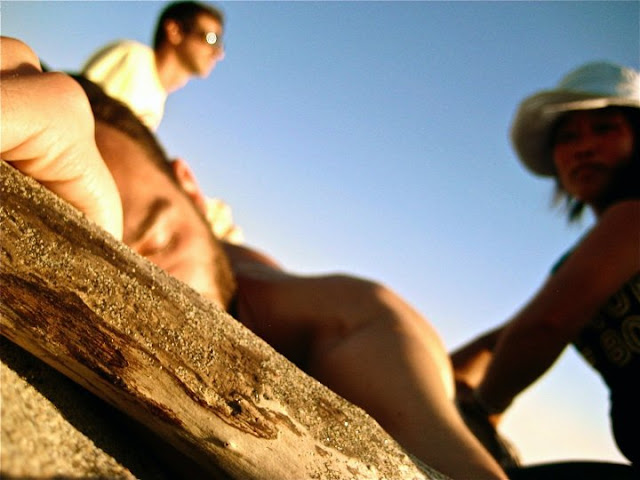 |
| Photo negative of the face of The Shroud of Turin. Photo of image in a pamphlet from The Photographic Display of the Shroud, Sanctuary of the Madonna of the Divine Love, Rome, Italy. |
 |
| Dr. Joe Nickell's book on the Shroud. He is the Senior Fellow of the Committee for the Scientific Investigation of Claims of the Paranormal. |
History and Claims
The Shroud of Turin makes it's first appearance in the history books in the 14th Century, in France. "We do know that by about 1357 the shroud was placed on view by the canons of Lirey. Great crowds of pilgrims thronged to exhibitions of the 'relic,' which was shown at full length and advertised as the 'true Burial Sheet of Christ,'" writes Joe Nickell, Ph.D. in his 1998 book Inquest On the Shroud of Turin: Latest Scientific Findings.
The idea is that after Jesus's, his body was removed from the cross and placed in this shroud, this sheet, and that an image of him remained there on the cloth. This image shows how the Shroud would have been wrapped around Jesus' body:
 |
| Photo of image from April 2010 edition of Oggi magazine. |
 |
| Modified photo of Shroud of Turin, from Wikimedia Commons |
In more modern times, Pope Benedict XVI spoke very vaguely and craftily about the Shroud in such a way that he did not actually say it is an authentic relic, the true Shroud of Jesus, but that allowed people to believe he had done so anyway. Check this out:
"Dismissing skeptics on Sunday when he visited the Shroud of Turin, Pope Benedict XVI said the burial cloth was none other than the same robe that once 'wrapped the remains' of Jesus Christ."That's journalist Nick Squire's subheadline in an article in The Christian Science Monitor on May 3rd, 2010. What the Pope actually said is that the Shroud, "wrapped the remains of a crucified man in full correspondence with what the Gospels tell us of Jesus." (the quote is in both that CSM article, and in translation in the Oggi magazine cited above.) He later cites the Pope also saying the shroud is ""an icon written in blood; the blood of a man who was whipped, crowned with thorns, crucified, and injured on his right side." This is classic politician speak from the Pope. If it is an icon, it is not a relic. He does say it is an icon, but doesn't bother mentioning that it is therefore not a relic. But, the journalists of the world worked their magic on those quotes just the same.
Much more clear though is Archbishop of Turin, Cardinal Giovanni Saldarini at the previous showing of the Shroud in 1998, who "insisted the shroud was not a relic (that is, not a burial cloth) but an icon (an artistic image)." (Nickell, p. 7, citing New York Times, April 19, 1998)
With the opposite view point is STURP, which is meant to stand for Shroud of Turin Research Project. They have in modern times insisted on a fair-minded, scientific study of the Shroud. "I personally believe it is the Shroud of Christ, and I believe this is supported by the scientific evidence so far," (Nickell, p. 115) said one member of the STURP team. And another: "I believe it through the eyes of faith, and as a scientist I have seen evidence that it could be his [Christ's] Shroud." (Nickell, p. 115) THEN, after making these statements, these supposed scientists were granted to permission to have access to the Shroud for what they were calling scientific study.
 |
| Waiting in line to see the Shroud of Turin |
My visit
 |
| The Shroud of Turin on display in Turin Cathedral, 2010 |
When we finally arrived in the Cathedral, the place was packed. Waiting in this long line got you the right to go up close to the shroud, within maybe 15feet, and remain there close for a few minutes.Then that group was ushered away and a new group of many dozen was ushered in.
The "Prayer of the Shroud" was being recited every few minutes as we shuffled towards the main attraction.
i was surprised by what i saw: The Shroud of Turin is a white sheet with burn holes on it. There is just the vaguest hint of any image at all! The photos that you see of the face, like the one at the top of this blog, are created by creating a photo negative of the image of the Shroud. Or, like the one of the whole Shroud from Wikimedia Commons, they've simply played with the contrast and color saturation of the photo itself.
 |
| The Shroud of Turin |
.jpg) |
| My zoomed in photo of the face of The Shroud of Turin. |
 |
| My photo of the Shroud of Turin with the modifications like the ones often used in the famous images of it. |
"No," the lady said.
"Without a flash?" the kid persisted.
"Non si potrebbe," she said, which is something like "No you shouldn't."
And then that kid and all the rest of us started taking photos! The kid was just inches away from the guard who had just said no, and nobody bothered anybody about it. Gotta love Italy! And, when in Rome!..so to speak.
Three possibilities of the truth
So what is the Shroud really? From what i can tell, there are there possibilities:
Possibility 1. It is the authentic Shroud of Jesus, and the image was created by residue of his actual crucifixion, ie., blood stains.
There are three major problems with this theory:
 |
| Cutting the Shroud of Turin? Image from Great Shroud of Turin FAQ |
Problem A. It has been Radio 14 carbon dated to be about 700years old. From a peer-reviewed article in Nature: International Weekly Journal of Science:
"Very small samples from the Shroud of Turin have been dated by accelerator mass spectrometry in laboratories at Arizona, Oxford and Zurich. As controls, three samples whose ages had been determined independently were also dated. The results provide conclusive evidence that the linen of the Shroud of Turin is mediaeval."But controversy has been stirred over claims that the Shroud had been mended 700years ago and the scientists had managed to only take samples of the mended parts.
Problem B. The facial image on the Shroud is of normal dimensions. But, when an image is created by putting a cloth-like material over a face (such as when making a death mask), the image comes out distorted, too wide. The two-dimensional view of a three-dimensional object is always distorted, as can be seen in this ancient Greek death mask of a Mycenaean king, sometimes thought to be the famous Agamemnon:
 |
| "Golden Mask of Agamemnon," Archeological Museum, Athens, Greece |
Problem C. A STURP scientist looked at the fibers of the colored parts of the Shroud under a fancy microscope to find out what caused the color. What did he find? "He had detected significant amounts of artists' vermillion and rose madder" as well as "ultramarine, azurite, orpiment, and wood charcoal - all known in the Middle Ages and suggestive of the shroud's presence at some time in an artist's studio." (Nickell, p. 124) In English? He found paint. It is paint, said the scientist commissioned by the Shroud of Turin Research Project to consider such questions. Very simple. That scientist, Walter McCrone, was then ostracized from STURP.
Possibility 2: It is the authentic Shroud of Jesus, but the image was created due to the miraculous power or intention of God.
 |
| Glowing Jesus? Image from Pope Alice |
If he wanted to make a permenant image, though, i think it would still be there. It just doesn't make sense that the deity would or could fail to make the image last forever, nor does it make sense to me that he would choose to make such an important image and then let it fade away. Even the ancient Greeks could make images that have lasted 3,000 years, i'm sure God himself could have lasted 2,000 without the image becoming a nearly blank sheet!
 |
| Remains of 3,000 year old painting from the ruins of Akrotiri, Santorini, Greece. Photographed in the Archeological Museum, Athens. |
Nevermind the fact that at least one scientist found under a microscope that it was a painting (some people even say Leonardo da Vinci painted it (Gianella, Oggi magazine, April 2010), though that presents its own whole new set of problems). Here is the story that makes me laugh out loud every time i think about it, that makes me sure it is a painting and not a relic:
At the turn of the 16th century, the owners of the Shroud at that time wanted to know whether it was in fact a miraculous image. To test this, they boiled the Shroud and scrubbed it to see if the image would come off -
AND IT DID! (Nickell, p. 107)
Like i said, you can't argue with what people believe, but for me the question became laughable 400years ago when they washed it and turned this remarkable painting into a nearly-blank white sheet!
 |
| The Shroud of Turin, nearly blank today. |





